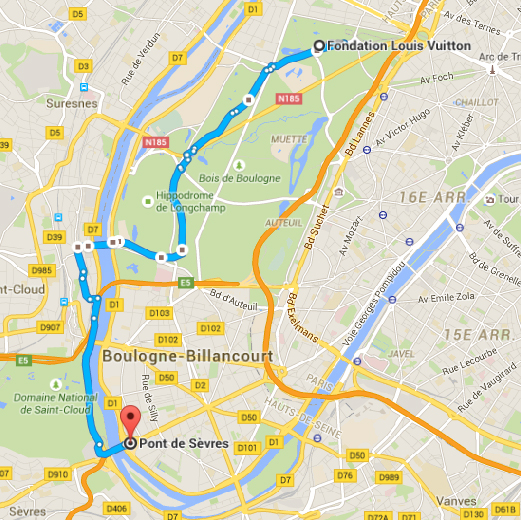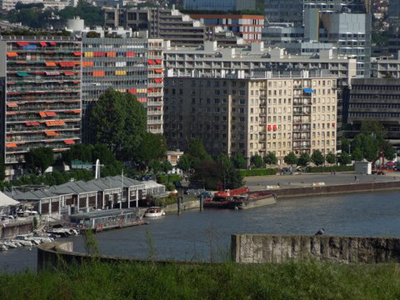Bike or run the Parc de Saint Cloud and Bois de Boulogne
Sometimes getting out of town means just going to the end of the metro line. There are really nice places to explore just beyond the edge of Paris in the banlieue*. Here’s a super bike ride or run of about 10km that takes you through the Bois de Boulogne, across the Seine on the Aqueduct de l’Avre footbridge, through the Parc de Saint Cloud, past the Cité de la Céramique to end at the Pont de Sèvres metro station in Boulogne.
Starting from the Fondation Louis Vuitton in the Bois, head down avenue Mahatma Gandi then turn left on the bike path heading south. This bike path starts on the right side of Allée de la Reine Marguerite. Continue on the bike path past the Rose Gardens of Bagatelle, follow the bike path and it’s wiggles through the intersection of la Grande Cascade and continue towards the Longchamp hippodrome. Circle around to the right the south end of Longchamp on Route de la Seine À la Butte Mortemart. Pass through the parking lot at the end of the street and cross the highway to find the ramp to go up on the bridge.

This bridge, constructed in 1891, was designed by Gustav Eiffel and it’s primary purpose is to carry the Aqueduct pipes across the Seine. The Aqueduct brings in water from the Avre river in Normandy to Paris. This is part of Pari’s drinking water. From the bridge enjoy the barges and possibly water skiers below.
On the Saint Cloud side follow the bridge over the tram tracks. At the end turn left on Avenue du Maréchal de Lattre de Tassigny. At the end of the street take the short the foot path uphill that connects to rue du Calvaire. At the next intersection continue straight on rue Gaston Latouche which turns into rue des Ecoles where you will find the entrance to the Parc de Saint Cloud.
Saint Clodoald, better known as Saint Cloud, was a Merovingian prince, grandson of Clovis I who became a hermit and monk. Clodoald found a hill along the Seine near Paris, (the present commune of Saint-Cloud). Here among the fishermen and farmers, he led a life of solitude and prayer, and built a church, which he dedicated in honor of Martin of Tours.
 The Park which is considered one of the « plus beaux jardins d’Europe » is 460 hectares of gardens with fountains, sculptures, and perspectives laid out by André Le Nôtre. It occupies the grounds of a chateau which was a residence of royal (think Catherine de Médicis and Marie-Antoinette) and imperial families from the 16th century up until Napoleon III. The chateau was destroyed during the Prussian attack on Paris in 1870. Today there remain a few structures from the gardens and a row on conical boxwoods that mark the location of the chateau. The park is the location of a annual fireworks display in September and the Rock en Seine festival in August. There are also several guinguette cafés which offer summer coolness.
The Park which is considered one of the « plus beaux jardins d’Europe » is 460 hectares of gardens with fountains, sculptures, and perspectives laid out by André Le Nôtre. It occupies the grounds of a chateau which was a residence of royal (think Catherine de Médicis and Marie-Antoinette) and imperial families from the 16th century up until Napoleon III. The chateau was destroyed during the Prussian attack on Paris in 1870. Today there remain a few structures from the gardens and a row on conical boxwoods that mark the location of the chateau. The park is the location of a annual fireworks display in September and the Rock en Seine festival in August. There are also several guinguette cafés which offer summer coolness.
If you feel like exploring this immense park head uphill to the view point called the rond point de la Balustrade where you’ll find La Lanterne guinguette for a lovely view over Boulogne and Paris. La Lanterne is named for a former lighthouse type structure modelled after one seen in Athens. When Napoleon I was home at the chateau the light was illuminated.
If you really have energy ride 5 kilometers farther west towards Marnes-la-Coquette to visit the Memorial de l’Escadrille Lafayette. This monument is dedicated to the pioneering volunteer American pilots of World War I.
There are many ways to wander through the Park, but if you are headed to the metro you will want to generally head along the Seine towards the south and downhill to arrive at the Cité de la Ceramique de Sèvres. From the Cité de la Céramique take the ramp up to cross the Seine to find Metro Pont de Sevrès, the end point of this trip.
The Seine furnishes half of the drinking water to Paris and the region. Other water comes from aquifers and aqueducts. Read about potable water in Paris.
* The word banlieue dates from the Middle Ages and comes from ban and leuca: the Germanic word bann refers to authority, jurisdiction and decrees and the Latin word leuca covers the distance of a league – approximately 4 kilometers. The banlieue was the space beyond the fortified wall of a duchy which was subject that duchy’s legal jurisdiction or bans.




